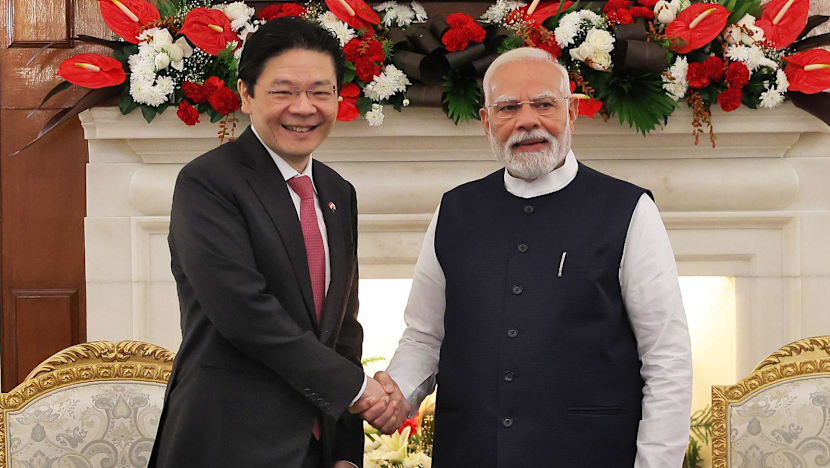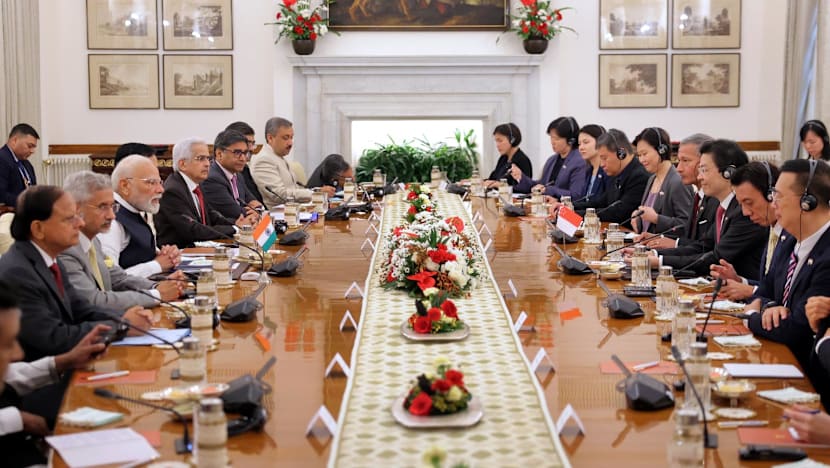Singapore and India set out road map to take Comprehensive Strategic Partnership forward
Under the road map, Singapore and India will cooperate more closely in areas like semiconductors and nursing skills development.

Singapore’s Prime Minister Lawrence Wong and India’s Prime Minister Narendra Modi meet at Hyderabad House in New Delhi on Sep 4, 2025. (Photo: Ministry of Digital Development and Information)

This audio is generated by an AI tool.
NEW DELHI: Singapore and India have set out a road map to take their partnership forward.
It includes plans for closer cooperation between the two countries in areas like semiconductors and nursing skills development.
Singapore’s Prime Minister Lawrence Wong and India’s Prime Minister Narendra Modi announced the road map on Thursday (Sep 4), the last day of Mr Wong’s official visit to New Delhi.
It comes as India and Singapore mark the 60th anniversary of their diplomatic relations.
Both countries elevated their ties to a Comprehensive Strategic Partnership (CSP), a high-level diplomatic relationship, during Mr Modi’s visit to Singapore last September.
The CSP road map is organised around eight areas: economic cooperation, skills development, digitalisation, sustainability, connectivity, healthcare and medicine, people-to-people and cultural exchanges, and defence and security cooperation.
Both leaders agreed that these areas are critical to securing long-term resilience in an increasingly complex global environment, Singapore's Ministry of Foreign Affairs (MFA) said in a statement.
The leaders also agreed to institutionalise the India-Singapore Ministerial Roundtable as the “foremost mechanism” to monitor the progress of the road map.

Speaking to the press, Mr Modi said: “Our relationship goes far beyond diplomacy. This is a partnership with purpose, rooted in shared values, guided by mutual interest and driven by a common vision for peace, progress and prosperity.”
He described Singapore as an important pillar of India’s Act East policy, and said India will continue to work with the Association of Southeast Asian Nations (ASEAN) to advance peace and stability in the region.
Mr Wong said the “ambitious and detailed” CSP road map charted the next phase of the relationship between India and Singapore.
The prime ministers did not take questions at the joint press conference.
Mr Wong separately told reporters that Singapore does not upgrade ties to CSP status with "very many countries".
"We do it because it is a substantive relationship which we want to nurture and cultivate and grow together for mutual benefit," he said.
That relationship is underpinned by people-to-people ties, and Singapore needs to build "a stronger base of broad understanding of India".
"We hope Singaporeans will be motivated and encouraged to spend time in some of the top Indian universities," said Mr Wong, who also noted India's vibrant start-up scene.
"If we can have more Singaporeans working here in India, if there are more people travelling to India to understand India, if we can collectively raise our understanding and appreciation of all that is happening in India, I think that would certainly help to strengthen the ties between our two countries, and enable us to do more together."
The Singapore government will continue to "highlight where the opportunities are and let businesses and investors sniff out and make deals on their own", he added.
Earlier in the day, Mr Wong was welcomed by Mr Modi on the lawn of Hyderabad House, a state guest house in New Delhi, where they shook hands. Both leaders also embraced at the end of their press conference.
Aside from bilateral ties, they also exchanged views on international developments during their meeting.
This included the need to promote economic integration, strengthen multilateralism and ASEAN-India relations, and uphold the rules-based international order, said MFA.
REVIEW OF TRADE PACT
Under the CSP road map, India and Singapore have agreed to deepen bilateral trade and market access by building on the Comprehensive Economic Cooperation Agreement (CECA) between both countries.
They also committed to making progress on starting a third review of CECA and achieving a “substantial” review of the ASEAN-India Trade in Goods Agreement (AITIGA) in 2025.
Mr Modi told the press that there would be a “time-bound” review of these trade pacts to accelerate trade. The bilateral CECA came into effect in 2005, while the regional AITIGA was implemented in 2010.
Asked about this, Mr Wong said the review of CECA was discussed briefly, and that officials will be working out the timeline.
Aside from CECA as a framework for free trade and investments, cooperation also takes place through the India-Singapore Ministerial Roundtable and Business Roundtable, he pointed out.
Singapore is India’s largest trade partner in Southeast Asia. Annual bilateral trade has more than doubled since CECA came into force, from S$20 billion (US$15.5 billion currently) to S$52.2 billion in 2023.
Singapore has also been India’s top foreign investor for seven years, while Indian investment into Singapore has also grown from S$481 million in 2004 to about S$31.6 billion in 2023.
Other areas of economic cooperation are in the semiconductor industry, industrial parks, capital markets, business-to-business engagement, the space sector and dispute resolution.
Both countries agreed to support the growth of India’s semiconductor ecosystem through channels like the India-Singapore Semiconductor Policy Dialogue.
They also agreed to facilitate partnerships with Singapore semiconductor companies, advance resilient supply chains, explore research and development together and promote workforce development.
NURSES’ TRAINING AND OTHER AREAS OF COOPERATION
In skills development, both countries will work together to develop capabilities in vocational education and establish a joint working group to this end.
India and Singapore will explore cooperation on artificial intelligence (AI) under the digitalisation umbrella.
They will share best practices for developing AI-ready data sets and build data-driven AI use cases in sectors like agriculture, healthcare and education.
In sustainability, both countries will explore cooperation in urban water management and civil nuclear technology, and deepen food security links.
There will also be deeper cooperation in nursing skills development, which will include enhancing the employability of nurses in Singapore. This is already being done at the state level with Assam.
To nurture people-to-people ties, India and Singapore will expand student exchanges, including at India’s Industrial Training Institutes.
They will also deepen defence technology cooperation in areas like quantum computing, AI, automation and unmanned vessels.















